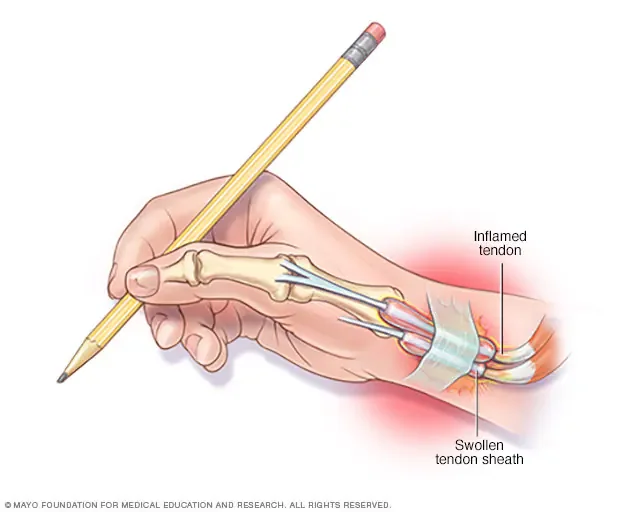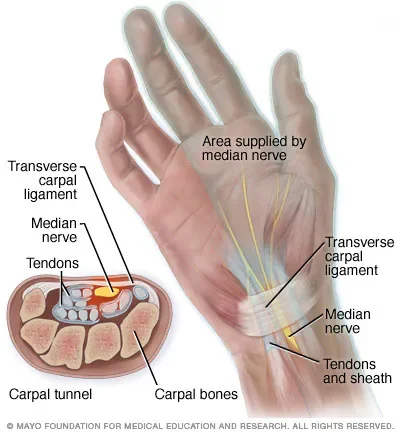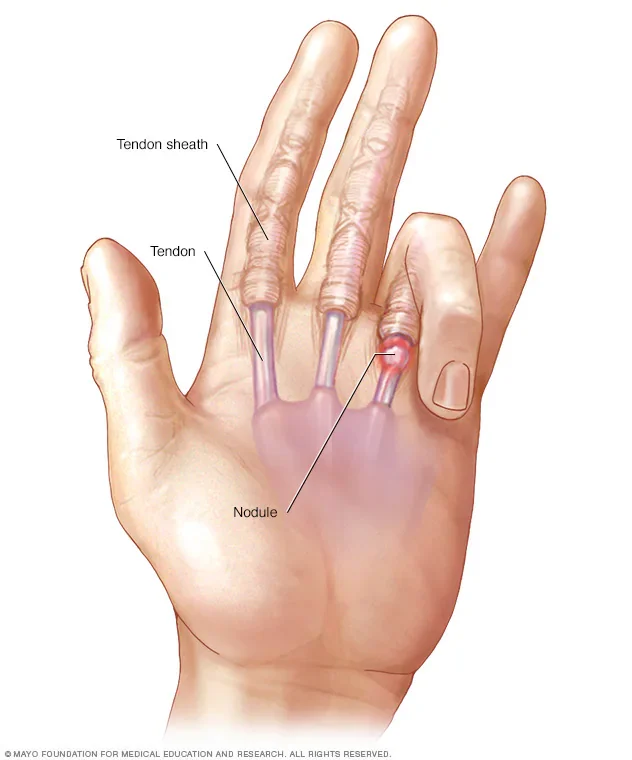de quervain's tenosynovitis
De Quervain tenosynovitis is a painful condition that effects the two tendons on the thumb side of the wrist. These tendons glide through a small tunnel at the base of the thumb, and when that tunnel’s lining becomes irritated often from repetitive hand or wrist movements the tendons swell and movement becomes restricted (Mayo Clinic, 2022). People with this condition typically feel pain near the base of the thumb, may notice swelling there, and often find thumb and wrist movements that involve grasping pinching or pronating to be painful (Mayo Clinic, 2022). While the exact cause isn’t fully understood, common contributing factors include things like repetitive hand motions (for example, I currently have this contrition from swinging a bat 100+ times ), direct injury to the wrist, and underlying inflammatory arthritis (Mayo Clinic, 2022). As an athletic training staff we can treat this with dry needling special taping techniques. But it is best treated promptly rather than “toughing it out” Because it can interfere with hand and wrist use if left untreated, awareness and timely care are important.
Carpal Tunnel
When someone has carpal tunnel syndrome, it means the median nerve which runs through a narrow passage in the wrist called the “carpal tunnel” is getting squeezed or compressed. Because that nerve helps control feeling and movement in parts of the hand, especially the thumb side, that pressure can lead to symptoms like tingling, numbness, or pain in the hand and fingers. People often describe it like their hand “falls asleep,” or that they keep dropping things especially at night, when the wrist might rest in a bent position. The discomfort might extend from the wrist into the palm or the fingers, and sometimes even up the forearm. The reasons this happens are varied and often involve a mix of things: wrist anatomy (if an individual’s tunnel is tighter by design), repetitive hand or wrist movements, fluid retention, and other health issues like obesity, diabetes, or thyroid problems. Because of that, Carpal Tunnel syndrome is pretty common it’s one of the most frequent nerve-compression issues seen in the arm and hand. This can be treated in many different ways, dry needling and nerve glides are among the first couple treatments an Athletic trainer will try. This is different from De Quervain’s because it involves the inflammation of the nerve specifically rather than the inflammation of the tendon itself.
Stenosing tenosynovitis
Stenosing tenosynovitis of the flexor tendons more commonly known as “trigger finger” is a condition where movement of one of the fingers (or all) becomes extremely painful when bending or straightening. Essentially, the tendons that bend the finger run inside a tight little tunnel made up of rings. Over time, the tendon or its lining may thicken or narrow in size, and the smooth gliding motion of the tendon is disrupted. What you feel is catching, popping, sometimes a “click” or “lock,” and pain at the base of the finger. That happens Because in the tendon, becomes irritated and the ring around it is tighter than normal, you may feel a lump or bump near the palm side of the base of your finger, some tenderness, and then when you bend or straighten the finger it may catch or lock. The exact cause isn’t always clear, but It can be associated with repetitive use, certain health conditions. For example, diabetes, rheumatoid arthritis, thyroid issues, hormonal changes, or simply the anatomy of the finger. But many cases happen without a specific triggering event. This must also be treated promptly because When the tendon can’t glide smoothly, not only is there discomfort, but the finger’s motion becomes abnormal you might find yourself needing to use your other hand to pull the finger free, or the finger gets stuck in a bent or straight position. If untreated, it can become more rigid. This is different from De Quervain’s because it involves the tunnel a lot more and there is a lot more “wear and tear” on rather than just inflammation.
stenosing tenosynovitis of the extensor pollicis longus tendon at the radial styloid process
This condition occurs when the tendon responsible for extending your thumb the extensor pollicis longus (EPL) tendon becomes irritated, inflamed, and constricted as it passes around the radial styloid process which is the bump on the lateral of your wrist. Because the tendon can’t glide smoothly through its sheath and around the bone, you experience pain, especially when moving the wrist or thumb. (Lee & Lee, 2018) In the reported case, the patient had pain on the thumb side of the wrist, especially when moving or bending the thumb and wrist. A standard test for a similar condition (De Quervain's tenosynovitis) was positive, but the culprit turned out to be the EPL tendon rather than the more common tendons of the first dorsal compartment. (Lee & Lee, 2018) Why it happens The underlying issue is that the tendon’s normal path or anatomy may be altered, and as it threads past the bony radial styloid, the sheath or the surrounding tissue can become tight, thickened, or inflamed. This creates extra friction, swelling, and narrowing all of which make the tendon hard to move freely. This is different from De Quervain’s because it involves the tunnel alot more and there is alot more “wear and tear” on rather than just inflamation but it is closely related to it because it is related to the thumb.
Word Analysis
Tenosynovitis
Teno- (P) tendon
Synov/o (CF) synovial membrane
-itis (S) inflammation
Arthritis
Arthr/o (CF)
-itis (S) Inflamation
Stenose
Sten/o (CF) Narrowing
Carpal
Carp/o (R) wrist
-al (S) Pertaining to

Project by an enrolled student at UNWSP
Medical Terminology course


